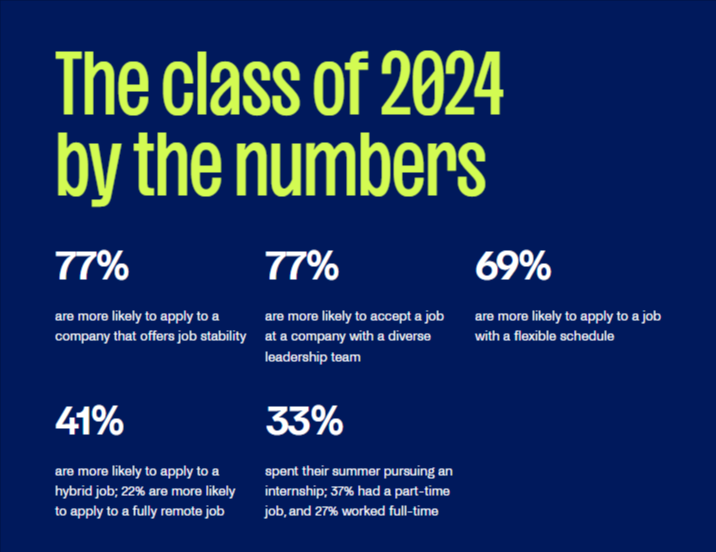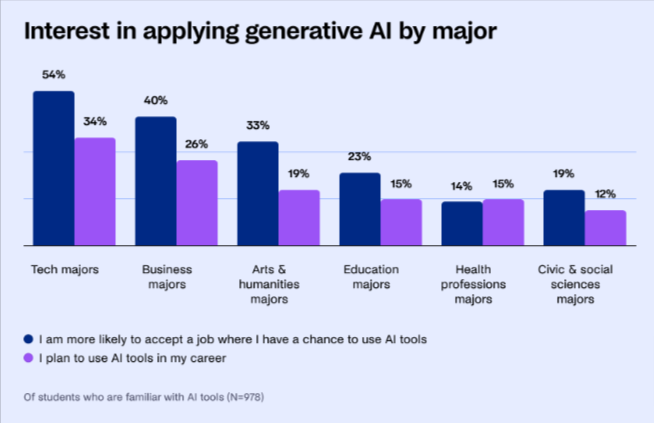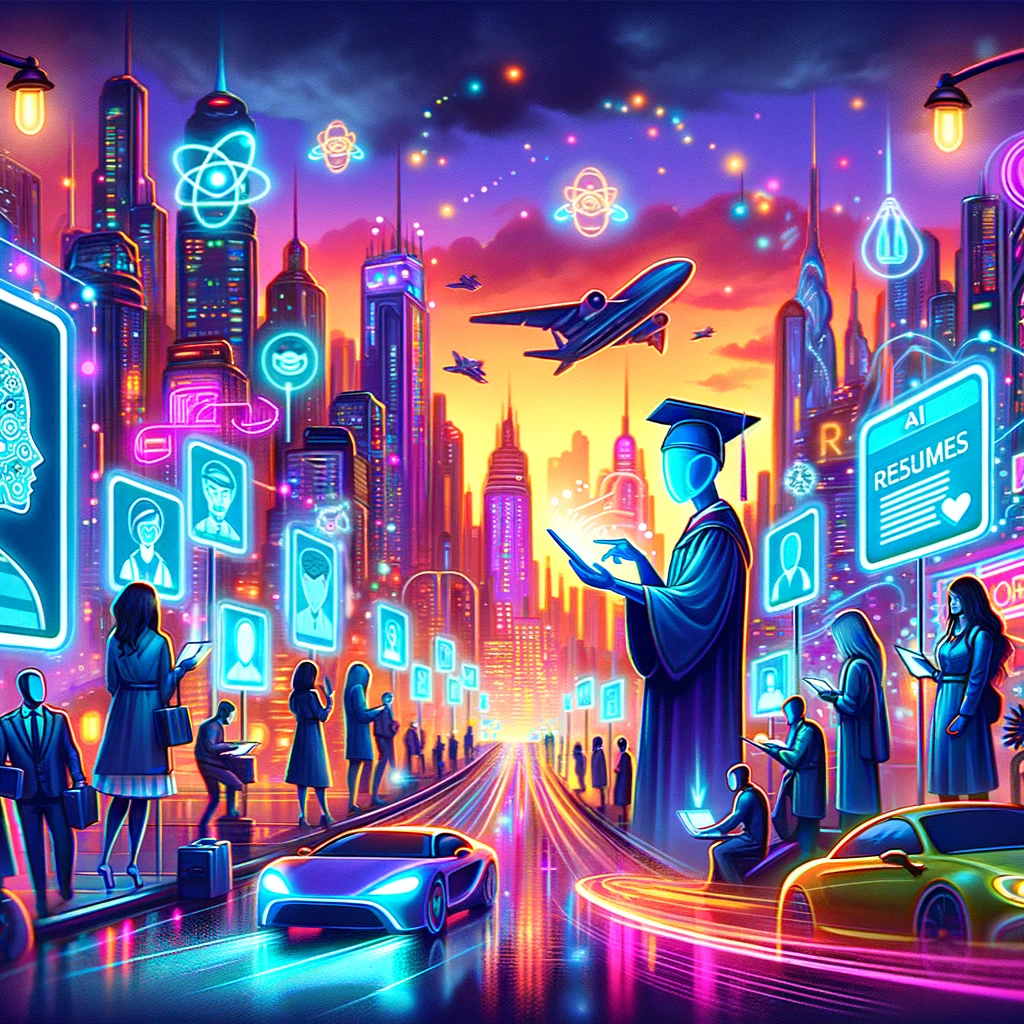By 2030, Gen Z will dominate 30% of the workforce, reshaping industries with tech-savvy skills and sustainability values. This demographic shift demands businesses adapt or risk obsolescence, highlighting the critical role of understanding and engaging Gen Z for future success
Forget the textbooks for a second! Today’s students are all about the future, not just grades. They’re tech-savvy, especially when it comes to AI, and they don’t just want a fancy job title – they want a life too, one that keeps their minds happy and their values intact. College debt and juggling side hustles might sound rough, but these future leaders are clear:
77% of them want stability in their careers, not just climbing the corporate ladder. That’s why 69% are seeking flexible schedules – they understand work shouldn’t compromise their well-being or personal commitments.
The Rise of Hybrid Roles: Balancing In-Person and Remote Work
Now, where do these future leaders envision working? While the office isn’t completely out of the picture, 41% are drawn to hybrid roles, allowing them to mix in-person collaboration with the freedom of remote work. For 22%, going fully remote is the dream, offering ultimate flexibility and potentially even travel opportunities.

These preferences highlight a generation that’s redefining success. It’s not just about the paycheck anymore; it’s about finding a career that aligns with their values and empowers them to live a fulfilling life, both inside and outside of work.
It’s clear that the Class of 2024 is entering the workforce with eyes wide open, and companies that can adapt to their demands are the ones who will attract and retain top talent.
The Generative AI Revolution: How the Class of 2024 Adapts and Thrives
The future is knocking, and it’s powered by AI. The Class of 2024, with their tech-savviness and forward-thinking approach, isn’t just aware of this new reality – they’re embracing it.
Familiarity with AI Tools
A whopping 75% are familiar with tools like ChatGPT and DALL-E, and half are actively seeking skills to navigate the generative AI landscape. This isn’t just techie curiosity; a third of graduates (and over half of tech majors) see generative AI as an integral part of their future careers.

Discover the fascinating world of AI through the eyes of tomorrow’s leaders! An impressive 54% of IT enthusiasts, 40% of commerce wizards, 33% of arts aficionados, 19% of civic and social science scholars, and even 14% of medical students are eager to dive into careers that harness the power of AI tools. This diverse interest across fields highlights the universal appeal and potential of AI to revolutionize not just technology, but every facet of our lives and work.
Adapting to the AI Revolution: Navigating Tomorrow’s Landscape

How exactly are these graduates adapting to this AI revolution? Here’s what we’re seeing:
1. Skill-Building Spree: From online courses to hackathons, students are actively upskilling. Learning how to interact with, interpret, and even create with generative AI is becoming a top priority. They understand that AI fluency is no longer a niche skill, it’s a career passport.
2. Early Adopters on the Rise: Whether it’s using AI to brainstorm marketing campaigns, generate personalized learning materials, or analyze data for research projects, students are putting their new skills to use. They’re not just passive consumers, they’re active participants in the AI ecosystem.
3. Collaboration is Key: While solo exploration is happening, there’s also a strong sense of community. Online forums, student-led workshops, and collaborative projects are fostering knowledge sharing and mutual learning. It’s a generation that understands the power of collective intelligence.
4. Looking Beyond Hype: Generative AI isn’t just a cool toy for these students. They’re aware of its limitations and potential biases. They’re critical thinkers, asking questions about ethical implications and responsible development. They want to be active shapers of this technology, not passive subjects.
The Class of 2024’s approach to generative AI is inspiring. They’re not simply waiting for jobs to adapt to them, they’re actively preparing to redefine the future of work itself. By embracing, understanding, and shaping this technology, they’re setting the stage for a future where human and machine intelligence work together to create a better world.
This is just the beginning! As generative AI continues to evolve, expect even more innovation and disruption from this generation of forward-thinking minds.
Financial Security Matters!
Graduation for the Class of 2024 isn’t just a cap and gown moment; it’s a plunge into a reality shaped by mountainous student loan debt (over half carry it) and the dynamic, often unpredictable gig economy. With 70% factoring debt into their job choices, financial security takes center stage. But this tech-savvy generation isn’t sitting idle – a third (33%) plan to hustle through side gigs to bridge the income gap.
So, how can these future leaders navigate this complex financial landscape? Here’s their playbook:
1. Tech Tools to the Rescue: Forget spreadsheets and calculators! Fintech AI-powered solutions are there that manage student loans, track spending, and even predict future financial needs. Imagine optimizing your finances with intelligent tools that personalize your debt repayment journey, identify hidden spending leaks, and even forecast your financial well-being years down the line.
2. Gig Economy Savvy: Side hustles offer flexibility, but maximizing income requires smart strategies. Time management mobile and desktop apps become your allies, and transparent freelance marketplaces help you avoid hidden fees. Upskilling in high-demand areas like content creation or virtual assistance, powered by AI tools for efficiency, can skyrocket your earning potential.
3. Redefining the 9-to-5: The traditional corporate ladder isn’t the only path to success. Embrace the remote work revolution, where location independence meets career opportunities. Consider becoming an entrepreneur, where AI tools fuel market research and marketing automation, giving you control and flexibility. Explore the booming creator economy, where your talent takes center stage.
The Class of 2024 faces a unique financial tightrope walk, but they’re armed with tech-savvy solutions, adaptable strategies, and a thirst for knowledge. By embracing innovative tools, navigating the gig economy strategically, and prioritizing financial literacy, this generation can rewrite the script, achieve financial security, and build a brighter future on their own terms.
Redefining Work-Life Balance
The Class of 2024 is entering the workforce not just with diplomas, but with a collective sigh of “enough is enough.”
80% have grappled with burnout, and the 69% valuing flexibility in scheduling clearly reflects their desire for a different work-life equation.
Gone are the days of sacrificing mental health for the corporate grind. This generation seeks employers who prioritize work-life balance (deeply important to a majority) and actively support mental well-being.
So, how can companies attract and retain this talented, yet cautious, generation? Here’s the key:
Embrace Flexibility: Forget the rigid 9-to-5; offer remote work options, hybrid models, and compressed workweeks. Empowering graduates to manage their time and responsibilities fosters both productivity and well-being.
RedBlink Technologies also promotes a hybrid work environment to its creative minds and we are happy to share that our out-of-box tech ideas are a result of this flexibility and open-communication.
Mental Health Matters: Don’t just pay lip service; prioritize mental health with tangible actions. Offer mental health resources, encourage breaks, and foster a culture of open communication. Remember, more than 15% of job descriptions now mention mental health, showcasing a growing trend companies can’t ignore.
Burnout Prevention, Not Reaction: Be proactive, not reactive. Implement clear boundaries, encourage workload management, and recognize early signs of burnout. Equip managers with the skills to support their teams’ well-being, fostering a healthy and productive work environment.
Technology as a Partner: Leverage technology to streamline tasks and reduce workload. Utilize AI-powered tools for time management, communication, and collaboration, freeing up time for employees to focus on meaningful work and personal needs.
The Future of Work is Human-Centered: Remember, graduates aren’t just employees; they’re individuals with innovative ideas that grow in a relaxed and stress-free environment, rather than in a rigid and bounded office environment.
By fostering a flexible, supportive, and technology-enabled work environment, companies can attract and retain top talent from this forward-thinking generation. It’s not just about work-life balance anymore; it’s about creating a work-life that enriches, not depletes, the human spirit.
By incorporating these strategies, companies can move beyond the traditional “work-life balance” struggle and create a human-centered work experience that resonates with the Class of 2024, leading to a more positive, productive, and sustainable future for all.
Embracing the Future: Hybrid Work Models Redefining Success
In today’s rapidly evolving workplace, hybrid work models have emerged as a beacon of flexibility, productivity, and employee satisfaction. These models blend the best of both worlds: the structure and camaraderie of in-office work with the autonomy and balance of remote work. As organizations worldwide navigate this new normal, several standout examples illustrate the effectiveness and potential of hybrid work models for fostering innovative, resilient, and thriving work environments.
1. Microsoft’s Balanced Approach
Microsoft, a global leader in technology, has adeptly implemented a hybrid work model that allows employees to work from home up to 50% of the time. This approach emphasizes productivity over physical presence, offering employees flexibility while maintaining a sense of connection and collaboration through regular in-office days. Microsoft’s model is supported by state-of-the-art technology for seamless communication and collaboration, setting a benchmark for how large corporations can successfully adapt to hybrid work.
2. Salesforce’s “Success from Anywhere” Model
Salesforce, a pioneer in cloud computing, has embraced a “Success from Anywhere” model, granting employees the freedom to choose where they work—whether at home, in the office, or in a café. This model is underpinned by a strong digital workplace strategy, utilizing Salesforce’s own technologies to ensure all employees, regardless of their location, feel included and engaged. Salesforce’s approach demonstrates the power of leveraging technology to foster a cohesive and adaptable work culture.
3. Spotify’s Work from Anywhere Program
Spotify, the world-renowned audio streaming platform, offers a Work from Anywhere program, allowing employees to choose their work location and even country. This radical flexibility acknowledges the diverse needs and preferences of its workforce, promoting a high degree of autonomy and trust. Spotify supports its employees with resources to set up a productive home office or to co-work, ensuring high levels of collaboration and innovation are maintained.
4. HubSpot’s Hybrid Flexibility
HubSpot, a leading growth platform, has introduced a hybrid model that categorizes employees into three categories: @office, @flex, and @home, based on their role and preference. This model provides tailored flexibility, recognizing the unique demands of different positions and personal preferences. HubSpot’s commitment to flexibility is also evident in its investments in technology and office redesigns, making both remote and in-office work more productive and enjoyable.
5. Dropbox’s Virtual First Policy
Dropbox, the file hosting service company, has adopted a Virtual First policy, prioritizing remote work while converting its office spaces into Dropbox Studios for collaboration and team gatherings. This approach acknowledges the importance of face-to-face interaction for creativity and relationship-building, while embracing the efficiencies and employee satisfaction benefits of remote work. Dropbox’s policy is a forward-thinking example of how companies can reconfigure their work environments to support hybrid models.
Redefine Success with RedBlink Technologies
Are you part of the visionary Class of 2024, ready to redefine success and embrace the AI revolution? At RedBlink Technologies, we’re not just building the future of AI; we’re offering you a front-row seat and the tools to shape it. Dive into a world where innovation meets flexibility, and your career is about more than just a job—it’s about making an impact, achieving financial security, and maintaining the work-life harmony you value.
Join us to explore cutting-edge AI projects, benefit from a culture that champions your well-being, and collaborate with a community that’s as forward-thinking as you are. Whether you’re looking to enhance your skills, kickstart your career in AI, or find a partner in your entrepreneurial journey, RedBlink Technologies is here to empower your aspirations.
Don’t just watch the AI revolution unfold—be a part of it. Discover how at RedBlink Technologies.
References
- What We Know About Gen Z So Far
- The Impact Of Gen-Z In The Workplace
- The Future of Jobs Report 2023 | World Economic Forum

Director of Engineering | CTO | Software Developer
Sunil Jain stands as a prominent figure in the tech industry, currently serving as the CTO at RedBlink Technologies. With a rich career exceeding 17 years, Sunil has carved a niche for himself in the realm of software development. His expertise spans across various sectors including Adtech, Insurance, Marketing, Lead Generation, and Medical, showcasing his ability to design enterprise-level solutions in diverse domains. Sunil’s role at RedBlink, a company known for its innovative approaches in technology, underlines his commitment to driving technological advancements. His extensive work experience, makes him a key player in shaping the future of software development and engineering.
